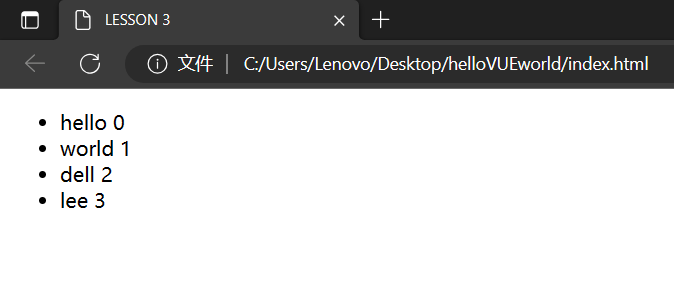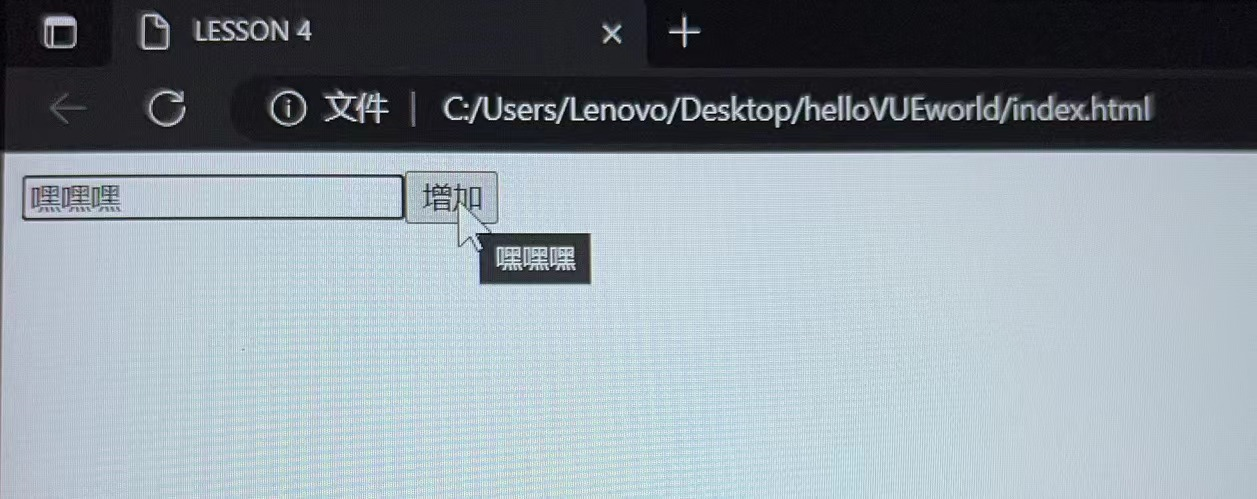vue语法初探
课前须知
知识储备:html、JavaScript、css(node、npm、webpack)
课程介绍
进阶式:
- 基础:生命周期函数 条件循环渲染指令、页面样式修饰语法···
- 组件:全局&局部、数据传递、插槽基础···
- 动画:单组件元素、列表&状态动画、CSS和JS动画···
- 高级扩展语法:Mixin混入、Vue的自定义指令、Teleport传送门···
- Composition API:产生背景、setup函数、响应式引用···
- 生态全家桶:vueCLI脚手架、大型工程、vue-Router、vue-X···
课程收获
- 理解运用vue3 原理 代码设计能力
- 移动端开发能力
- 公司级别项目
以 Visual Studio Code为例,
hello world
<!DOCTYPE html>
<html lang="en">
<head>
<meta charset="UTF-8">
<meta name="viewport" content="width=device-width, initial-scale=1.0">
<title>hello world</title>
<script src="https://unpkg.com/vue@next"></script>
</head>
<body>
<div id="root"></div>
</body>
<script>
Vue.createApp({ #我要创建一个vue实例
template: '<div>hello world</div>' #在root这个元素里展示模板
}).mount('#root'); #让实例作用于root这个元素
</script>
</html>
倒计时(修改后半)
<body>
<div id="root"></div>
</body>
<script>
Vue.createApp({
data(){
return{
content:1
}
},
mounted(){
setInterval(()=>{
this.content += 1;
},1000)
},
template: '<div>{{content}}</div>'
}).mount('#root');
</script>
</html>
字符串反转和内容隐藏
Vue.createApp({
data(){
return{
content:'hello world'
}
},
methods:{
handleBtnClick() {
this.content = this.content.split('').reverse().join('');
}
},
template: `
<div>
{{content}}
<button v-on:click="handleBtnClick">反转</button>
</div>
`
}).mount('#root');
</script>
</html>
对 vue指令 “v-on” 其 “绑定(click)事件” 并 定义在 methods 里
Vue.createApp({
data(){
return{
show : true
}
},
methods:{
handleBtnClick() {
this.show = !this.show ;
}
},
template: `
<div>
<span v-if="show">你看见我啦</span>
<button v-on:click="handleBtnClick">你看不见我!</button>
</div>
`
}).mount('#root');
</script>
</html>
操作效果如下

介绍 “v-if”指令 ,定义 show 变量用以控制显示与否
span标签到底存不存在取决于 show 值
todolist 小功能——循环和双向绑定
Vue.createApp({
data(){
return{
list:['hello','world','dell','lee']
}
},
template: `
<ul>
<li>hello</li>
<li>world</li>
<li>dell</li>
<li>lee</li>
</ul>
`
}).mount('#root');
</script>
</html>
将
内的部分替换为:
`template: ``
<ul>
<li v-for="item of list">{{item}} test </li>
</ul> ```
显示效果(除“test”字样)一致。
若:
<ul>
</ul>
则可如图示打印出下标



Vue.createApp({
data(){
return{
inputValue:'', 定义一个空值
list:[]
}
},
methods:{
handleAddItem(){
this.list.push("hello");
}
},
template: `
<div>
<input v-model="inputValue" /> 双向绑定,此处的inputvalue变化引起data里同名的变化
<button v-on:click="handleAddItem">增加</button>
<ul>
<li v-for="(item, index) of list">{{item}} {{index}}</li>
</ul>
</div>
`
}).mount('#root');
组件概念——对todolist拆解
Vue.createApp({
data(){
return{
inputValue:'',
list:[]
}
},
methods:{
handleAddItem(){
this.list.push(this.inputValue);
this.inputValue = '';
}
},
template: `
<div>
<input v-model="inputValue" />
<button v-on:click="handleAddItem"
v-on:click="handleAddItem"
v-bind:title="inputValue" bind指令:希望title属性和某数据绑定
>
增加</button>
<ul>
<li v-for="(item, index) of list">{{item}} {{index}}</li>
</ul>
</div>
`
}).mount('#root');
鼠标放在button上会展示输入框的内容:
“前端要拆组件”,组件就是页面上的一部分,可以是input框,可以是button···
const app = Vue.createApp({
data(){
return{
inputValue:'',
list:[]
}
},
methods:{
handleAddItem(){
this.list.push(this.inputValue);
this.inputValue = '';
}
},
template: `
<div>
<input v-model="inputValue" />
<button
v-on:click="handleAddItem"
v-bind:title="inputValue"
>
增加</button>
<ul>
<todo-item v-for="(item, index) of list"/>
</ul>
</div>
`
});
app.component('todo-item',
{
template:'<div>hello world</div>'
}
);
app.mount('#root');
</script>
</html>



【推荐】国内首个AI IDE,深度理解中文开发场景,立即下载体验Trae
【推荐】编程新体验,更懂你的AI,立即体验豆包MarsCode编程助手
【推荐】抖音旗下AI助手豆包,你的智能百科全书,全免费不限次数
【推荐】轻量又高性能的 SSH 工具 IShell:AI 加持,快人一步
· TypeScript + Deepseek 打造卜卦网站:技术与玄学的结合
· Manus的开源复刻OpenManus初探
· AI 智能体引爆开源社区「GitHub 热点速览」
· C#/.NET/.NET Core技术前沿周刊 | 第 29 期(2025年3.1-3.9)
· 从HTTP原因短语缺失研究HTTP/2和HTTP/3的设计差异